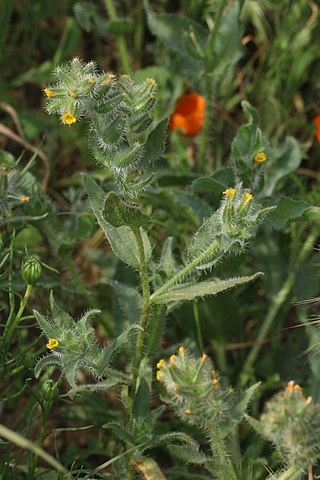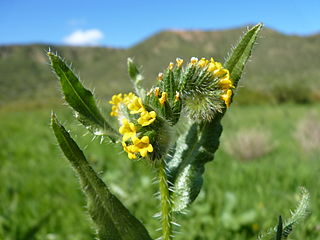
Root-knot nematodes are plant-parasitic nematodes from the genus Meloidogyne. They exist in soil in areas with hot climates or short winters. About 2000 plants worldwide are susceptible to infection by root-knot nematodes and they cause approximately 5% of global crop loss. Root-knot nematode larvae infect plant roots, causing the development of root-knot galls that drain the plant's photosynthate and nutrients. Infection of young plants may be lethal, while infection of mature plants causes decreased yield.

Meloidogyne incognita, also known as the southern root-nematode or cotton root-knot nematode is a plant-parasitic roundworm in the family Heteroderidae. This nematode is one of the four most common species worldwide and has numerous hosts. It typically incites large, usually irregular galls on roots as a result of parasitism.
Belonolaimus longicaudatus is a common parasite of grasses and other plant crops and products. It is the most destructive nematode pest of turf grass, and it also attacks a wide range of fruit, vegetable, and fiber crops such as citrus, cotton, ornamentals, and forage. The sting nematode is a migratory ectoparasite of roots. It is well established in many golf courses and presents a problem in turf management. The sting nematode is only present in very sandy soils. It cannot reproduce in heavier or clay soils.

Rotylenchulus reniformis, the reniform nematode, is a species of parasitic nematode of plants with a worldwide distribution in the tropical and subtropical regions.
Pratylenchus brachyurus is a plant parasitic nematode.
Anguina tritici is a plant pathogenic nematode.
Xiphinema index, the California dagger nematode, is a species of plant-parasitic nematodes.
There are many plant-parasitic species in the root-knot nematode genus (Meloidogyne) that attack coffee such as M. incognita, M. arenaria, M. exigua, M. javanica and M. coffeicola. Study has already shown interspecific variability coffee, in which show how this species can be adapting to new hosts and environments.

Anguina agrostis is a plant pathogenic nematode.

Anguina is a genus of plant pathogenic nematodes.
Anguina graminis, the fescue leaf gall nematode, is a plant pathogenic nematode.
Anguina balsamophila is a plant pathogenic nematode in mules ear.

Nematology is the scientific discipline concerned with the study of nematodes, or roundworms. Although nematological investigation dates back to the days of Aristotle or even earlier, nematology as an independent discipline has its recognizable beginnings in the mid to late 19th century.

Amsinckia menziesii is a species of plant in the family Boraginaceae, the borage or forget-me-not family.

Amsinckia eastwoodiae is a species of fiddleneck known by the common name Eastwood's fiddleneck. It is endemic to California, where it grows in the varied plant habitat of the hills, mountains, valleys, and coastlines.

Amsinckia lycopsoides is a species of fiddleneck known by the common name tarweed fiddleneck or bugloss fiddleneck. It is one of the more common species of fiddleneck. It is native to much of western North America from California to British Columbia. It can be found in a wide variety of areas.

Amsinckia tessellata is a species of fiddleneck known by the common names bristly fiddleneck, tessellate fiddleneck, checker fiddleneck, and devil's lettuce.

Amsinckia calycina, also known as hairy fiddleneck or yellow burweed, is a species of fiddleneck. It is native to Argentina and Chile and naturalised in Australia. It is an annual herb, growing to between 15 and 50 cm high and has pale yellow flowers. The species is poisonous to mammals.
Heterodera zeae, the corn cyst nematode (CCN), is a plant parasitic nematode that feeds on Zea mays (maize/corn). The CCN has a limited economic impact worldwide due to its high soil temperature requirements.

Root-gall nematodes are plant-parasitic nematodes from the genus Subanguina that affect grasses, including cereals, and some other plants, such as mugwort. They are distinct from the Root-knot nematodes which are from the genus Meloidogyne. So far around twenty-five separate species of Subanguina have been identified, although the most well-known and type species is Subanguina radicicola.









